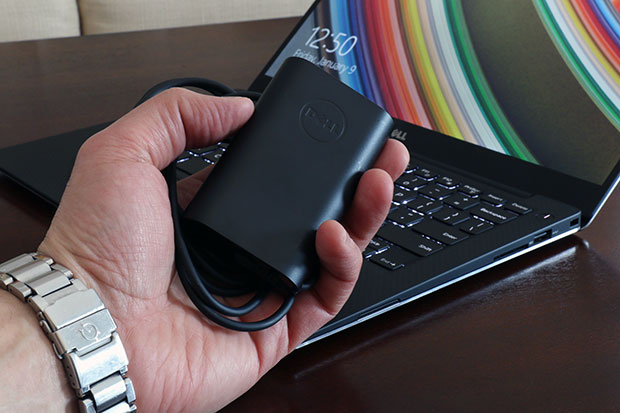With most manufacturers driving size and weight out of utlrabook designs wherever possible, it's all too easy to compromise structural integrity and build quality in an over-zealous attempt to achieve a new kind of thin. However, clearly Dell didn't rank Z-height dimensions as the top, above-all-else design criteria with the new XPS 13. The machine is still thin and light but it's also solid and well-built from every angle.


Dell did take the time, however, to really crunch down the size of the AC adapter brick for the new XPS 13. It's not a heck of a lot bigger than the average smartphone charger, which really helps minimize bulk in a travel bag or backpack. The good news is, even though it's tiny, it doesn't get too warm and appears to be able to do its job with minimal strain.

In case you were wondering how viewing angles are with the 2015 XPS 13's 3200x1800 Infinity Touch display, this picture ought to give you a little insight. It's a semi-glossy panel with a Corning Gorilla Glass NBT covering, but, other than a bit of glare and reflection on occasion, viewing angle capability is excellent. In addition, with 400 nits brightness, the display is very vibrant and well-balanced with good saturation.
And why would you want bezel getting in the way of such a great notebook display? You wouldn't, and Dell really pushed the envelope in this area. However, they built the display in such a way that it fuses the machined aluminum lid of the machine with the display panel, so it's essentially all one piece. The design offers great rigidity and a durable feel for an otherwise extremely thin frame.


On the right and left edges of the machine you get the standard assortment of USB 3.0 (with PowerShare charging), mini DisplayPort and headphone jack IO options. Dell also included the SDCard slot in this iteration of the XPS 13, as well a battery level indicator button and LED status array. Finally, instead of a Kensington lock slot, Dell went with a Nobel lock slot.



The keyboard area of the 2015 XPS 13 is another highlight. It's built from a carbon fiber composite material that is used throughout the entire top half of the chassis. It has a soft touch rubberized feel to it that resists fingerprints well and appears to be a composite of a high density plastic with carbon fiber, that results in a light weight shell that also feels strong and has virtually no give under pressure of even the heaviest of keyboard mashers. It looks great too. The only downside I would offer is that things felt cramped for me, though I personally like roomy keyboards and have larger-than-most type hands. In order to make the new XPS 13 so small, Dell had to squeeze a lot of keys in less deck area. Physics just got in the way. However, Dell's backlit key caps have plenty of travel and decent tactile response. This machine has a very high quality keyboard area in general; it just took me a bit of time to get used to its space constraints. Others may not experience this same learning curve.

Finally, a couple of early questions we got on our
initial previews of the
2015 XPS 13 were related to the battery and venting in the chassis. The shot above answers those questions pretty cleanly. In short, the 2015 Dell XPS 13's battery is not user serviceable and, as you can see, the primary venting location for this machine is underneath at the back of the machine, near the display. This venting area never got too warm during testing and heat was never an issue even during heavy use. In terms of fan noise, we've seen reports from other journalists that suggest the 2015 XPS 13's fan can get "loud" under load. This is complete hogwash in our opinion. You can hear it spin up under very heavy workloads but this fan is anything but "loud." The word we'd use is "quiet," especially for such a small, light machine with this kind of horsepower on board. Is it silent? No. Was it at all "loud" at any time during our tests? Absolutely not.















